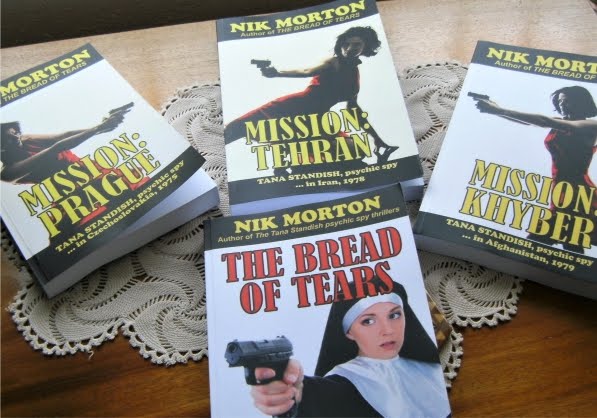Tom Rizzo kindly asked me to answers seven questions for his regular Tuesday spot on his blog - Story Teller’s Seven
That interview is here:
Now, I reckoned I should return the favour, so these were my seven questions.
1.
Heroes and Rogues looks like a fascinating book, judging by the entries
on your website. You obviously had great fun collecting and writing the varied
articles. I’d like to add it to my collection. When is it appearing on Amazon
and elsewhere?
TR: I did have great fun putting that together. I find characters from
frontier America as fascinating as fictional characters. At the moment Heroes
& Rogues is available only from my website as an incentive to sign up for a
newsletter. But, I'm in the process of expanding it with additional snapshot
profiles. Then I'll make it available on Amazon in digital form, and replace
the newsletter "incentive" with something else.
2. Whereabouts
in Great Britain did you live – and for how long? Any memories of your stay? (I
know: that’s sort of 3 questions in one!)
TR: I lived in Southwest England, the Cotswolds for four
years--Gloucestershire County. I have lots of memories of my time there. At the
time, there were no freeways; the country had just started to build its first
one--the M1, I think. Before I had a car, I used to hitchhike quite a bit
and met the most interesting characters. It was an educational experience.
One night, in the rain, I hitched a ride with a lorry (truck) driver.
While we were sliding and bouncing along, I asked him what he was
transporting. "Explosives, mate." I rode the rest of the way with my
fist curled around the door handle in case I had to manage a quick escape.
3. Your
western Last Stand at Bitter Creek features a black officer, David
Webster. I’ve come across very few black main characters in westerns – DM
Harrison’s The Buffalo Soldier, Frank Roderus’ The Outsider,
Brian Garfield’s Tripwire, and the Cash Laramie adventures featuring
Gideon Miles spring to mind... What prompted you to use a black protagonist?
TR: I learned that about 190,000 or so black soldiers served in the
Union Army and Union Navy, but still endured discrimination and segregation,
even though they made significant contributions in the war and put their lives
on the line as much as anyone else. The army was reluctant to commission black
officers, which numbered between 90 and 120. The Lincoln administration
initially worried that recruiting black troops would alienate border states and
give them a reason to secede. The idea of a black soldier serving as
a Union spy intrigued me. Making him an integral part of the plot, and
equipping him with skills perhaps not normally associated with black soldiers,
I think, gave the story a broader appeal. At least that was my intent.
4. Can
you describe where you’re going with your latest book?
TR: I'm in the process of outlining the next novel, which will feature
both Bonner and Webster. I had such good feedback on both, I wanted to create a
storyline where they'll be paired again, this time in search of another stolen
treasure.
5.
You’re keen on the importance of research and have warned about the
danger of doing too much. Have you now evolved a method of handling research so
it doesn’t take over timewise, and have you any fascinating nugget that has
jumped out recently?
TR: Too much research, of course, sucks the time from actual
storytelling. But the research I did for Last Stand At Bitter Creek was
important because it enabled me to get a solid sense of time and place for the
last half of the 19th century. Since I have the "background"
information in place, most of my research involves connecting the dots, so to
speak, in terms of the actual character and events that parallel the time frame
I use for my story.
6.
Okay, you're in a small café, huddling with three of your favorite writers
(living or dead). One specializes in Westerns; another in Thrillers; the third
in Short Stories. Who would they be, and what one – and different – question
would you ask each of them?
TR: Raymond Carver who, in
his day, revitalized American short story telling. Carver focused on ordinary
people who find themselves in ordinary - and sometimes bizarre - emotional
conflicts. My question: "In what ways does real life reflect the untidy endings you
write about in your stories?"
Louis L'Amour -- because (1) the way he was able to bring the characters and the
landscape of the American frontier to life, and (2) for his passion at treating the
Western as history. I'd ask: "What role, and in what ways, did the American
frontier shape the American character?"
David Morrell -- I'd ask him, "As backgrounding for your stories, you've
become a private pilot, been trained in firearms, hostage negotiation,
executive protection, expert driving strategies, assuming identities, and other
things. Obviously, this all helps in creating reality in storytelling. But what
advice would you give to a writer who has neither the time nor money to learn
such things, but wants to write as compelling a story as you do?"
7.
How would you finish this statement: "I bet my readers didn't know (this
about me) …”?
TR: I once had lunch with
Elvis Presley's manager, Col. Tom Parker, in Las Vegas.
Thanks, Tom.





























